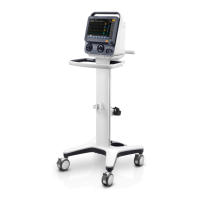D-6
Device Failure 03 H
Power Board Selftest Error.
Contact your service personnel.
Device Failure 06 H
Ctrl Module Selftest Error.
Contact your service personnel.
Device Failure 07 H
Insp. Module Comm stop.
Contact your service personnel.
Device Failure 08 H
Exp. Module Comm stop.
Contact your service personnel.
Device Failure 09 H
Pressure Sensor Failure.
Contact your service personnel.
Device Failure 10 H
Safety Valve Failure.
Contact your service personnel.
Device Failure 12 H
Insp. Limb Failure.
Contact your service personnel.
Device Failure 13 H
O
2
Limb Failure.
Contact your service personnel.
Device Failure 14 H
Turbine blower Failure.
Contact your service personnel.
Device Failure 15 H
Turbine blower Temp Too High.
Contact your service personnel.
Device Failure 16 H
Insp. Valve Disconnected.
Contact your service personnel.
Device Failure 17 H
Insp. Module Selftest Error.
Contact your service personnel.
Device Failure 18 H
Exp. Module Selftest Error.
Contact your service personnel.
Device Failure 21 H
Pressure Sensor Zero Point Error.
Contact your service personnel.
PEEP Too High H
Monitored PEEP exceeds PEEP+5 cmH
2
O (PEEP+10
cmH
2
O for APRV mode) within any fully mechanical
ventilation cycle.
1. Check the ventilation parameter setup.
2. Check the patient tubing for occlusion.
PEEP Too Low M
Patient’s PEEP is less than the setting value to a certain
extent.
1. Check the patient tubing for leakage.
2. Perform System Check to test the leakage.
Airway Obstructed? H
Tube is occluded.
1. Check and clean the patient tubing.
2. Check and clean the expiration valve.
Sustained Airway
Pressure
H
The airway pressure measured by any pressure sensor is
greater than or equal to the setting PEEP+15 cmH
2
O for
continuous 15 s.

